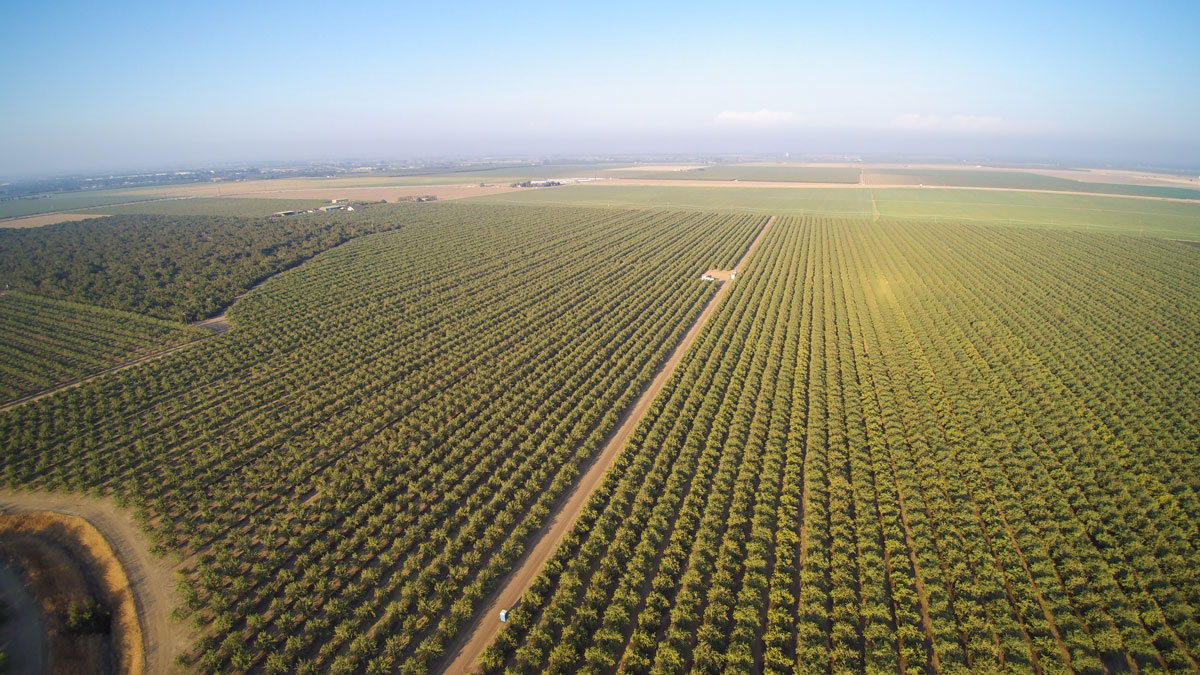How Danone Supports California Farmer’s Regenerative Ag Practices
A look at how Danone’s partnership with a California farm promotes regenerative agriculture.

March 2023
Volume 77, No. 2
Woolf Farming is one of Danone’s partners in the promotion of regenerative agriculture. The outfit operates 25,000 acres in California’s farming-rich Central Valley, raising crops from almonds and pistachios to garlic, tomatoes, and cotton.
Danone buys almonds from Woolf for use in its almond-based nondairy products and pays Woolf about $50 an acre each year to offset Woolf’s costs of cover-cropping with triticale, legumes, and flowering plants that help pollinators. Danone’s funds also help Woolf’s own research into cover-cropping practices.
Among other things, the cover crops boost water retention for notoriously thirsty almond trees. “If we’re able to improve water penetration, we can run fewer hours of water because we don’t have to make up for the runoff,” explains Daniel Hartwig, Woolf’s resource manager. “We can reduce by maybe 4%–5% the amount of water we need through soil health practices.”
As for Danone, the company “gets the knowledge that they’re helping to improve soil health, helping to store carbon, which is improving the world,” Hartwig says.
Woolf has adopted other regenerative practices, such as developing a 10-acre garden to attract bees and other pollinators amid an on-farm array of solar panels. And it is bringing in more compost from local vendors to use on its trees and row crops. “It helps us reduce our reliance on synthetic fertilizers,” Hartwig says.
Digital Exclusives

10 Food Trend Predictions for 2022
The editors at Food Technology magazine, published by the Institute of Food Technologists (IFT), have announced their predictions for the hottest food trends for 2022.
Food Technology Articles

How to Achieve EPR-Forward Packaging, Part 2
In this two-part series, the author explores the history of Extended Producer Responsibility (EPR), what is needed to help EPR succeed, and how brands can best prepare for EPR.

How to Achieve EPR-Forward Packaging
In this two-part series, the author explores the history of Extended Producer Responsibility (EPR), what is needed to help EPR succeed, and how brands can best prepare for EPR.

Keeping the ESG Promise
An infographic describing food and beverage companies’ outlooks regarding ESG initiatives.

Ag-Tech’s Passionate Pragmatist
Agrologist and agricultural futurist Robert Saik wants to feed the world better and more sustainably. To make that happen, leveraging science and technology will be critical.

The State of Sensory Science
Three seasoned sensory scientists share their thoughts on the complexity of measuring consumer perceptions, the value of academic/industry collaboration, the evolution of the discipline, and why they love what they do.
Recent Brain Food

Supporting Sustainable Innovation
Health, welfare, and sustainability concerns have spurred consumers to explore plant-based alternatives. In this sponsored content interview, global ingredients company ofi discusses the forces driving this growing trend, and how it supports product innovation in this emerging category.
IFT Science and Policy Team Forecasts Six Trends for 2023
From a processed foods comeback to breaking food system silos and addressing food and nutrition security, our science and policy experts identify top science of food trends.
ICYMI: Our Most-Popular Business FIRST Conversations Available Online
Tune in to the IFT FIRST on-demand content channel and hear from experts and innovators who are making big impacts.
IFT Scientists' Top 5 Food Trends to Consider in 2022
What's on the horizon for the global food system in 2022? IFT’s Science and Policy Initiatives team gives their predictions on five trends that are expected to take shape in the new year.
New Program Highlights Untapped Potential of Using Food Science for Relief and Development Initiatives
The new field of Food Science for Relief and Development (FSRD) offers a fresh, high-impact approach to tackling problems of global food security, poverty, and malnutrition.


